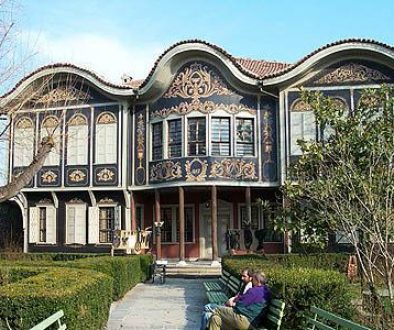Melnik
 Tucked away in the south-western slopes of the Pirin Mountain, Melnik is the smallest town in Bulgaria. It has been declared a cultural and historical reserve and a museum town.
Tucked away in the south-western slopes of the Pirin Mountain, Melnik is the smallest town in Bulgaria. It has been declared a cultural and historical reserve and a museum town.
The climate of Melnik is favorable for the treatment of pulmonary, renal and rheumatic disorders.
Melnik is a combination of unique natural surroundings – rocks towering over houses perched on hills – legendary history, culture and wine.
One cannot but admire the white houses cuddling one on top of the other, with beautiful bay windows and quiet yards amid the greenery and tranquility of past glories.
Few visitors are aware that today’s pretty town, nestling between the hills, used to be an important economic and spiritual center of over 25 000 inhabitants, around 1300 houses and more than 70 churches. It was probably ancient Thracians who lay the foundations. The steps of Slavs, Bulgarians, Greeks, Latins and Turks mingle and overlap on these narrow cobbled streets…
 Besides history and architecture, Melnik also means wine. The stone pyramids encircling the town house unique carved cellars in which the famous Melnik wine ripens, matures and is preserved. Such technology can hardly be found elsewhere. Connoisseurs in neighboring Turkey and also in far-off France and Spain put their preference on the taste of this palatable, thick, mature wine.
Besides history and architecture, Melnik also means wine. The stone pyramids encircling the town house unique carved cellars in which the famous Melnik wine ripens, matures and is preserved. Such technology can hardly be found elsewhere. Connoisseurs in neighboring Turkey and also in far-off France and Spain put their preference on the taste of this palatable, thick, mature wine.
Currently the town’s population is about 230 residents but it has enormous development potential in tourism.
The antique atmosphere sending the visitor back in time to the grandeur of past ages is unique indeed.
Antique Melnik houses impress one with their rich architecture, their wine cellars, the interior decoration.
The most popular among them are: The Kordoupoulov’s house (the largest on the Balkan peninsula from the Revival period) with its fascinating murals and enormous cellar; The Bolyar’s house (the oldest surviving house in Bulgaria). Also worth seeing are the ruins of the Sveti Nikola Monastery (12th c.), Slav’s fortretress (13-14c.), the Roman Bridge, the old Turkish hammam and the remains of several churches that used to be as many as 75 in the past.
 Here one can also see those wondrous geological formations shaped of white crumbly sandstone – the Melnik Pyramids. Over the millennial erosion has shaped these fascinating figures over an area of 17 sq.km. Using one’s imagination, these can be seen as gigantic mushrooms, ancient towers or obelisks.
Here one can also see those wondrous geological formations shaped of white crumbly sandstone – the Melnik Pyramids. Over the millennial erosion has shaped these fascinating figures over an area of 17 sq.km. Using one’s imagination, these can be seen as gigantic mushrooms, ancient towers or obelisks.
Not far from the town (6 km) lies the Rojen Monastery a stronghold of Christian faith and arts, and 20 km to the northeast is the unique locality of Rupite.



